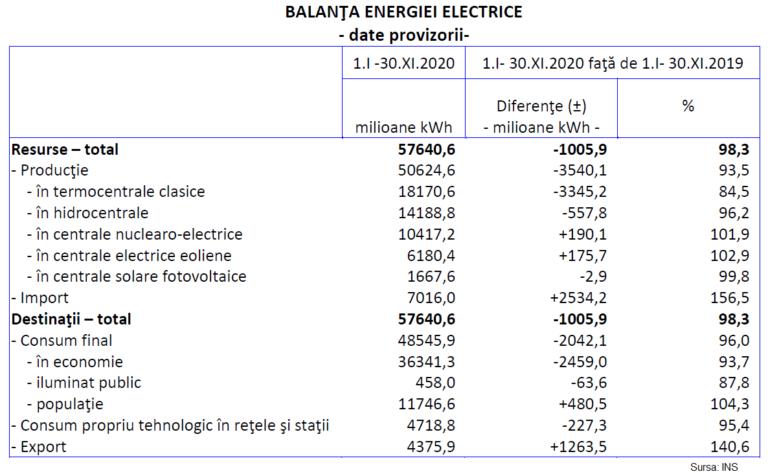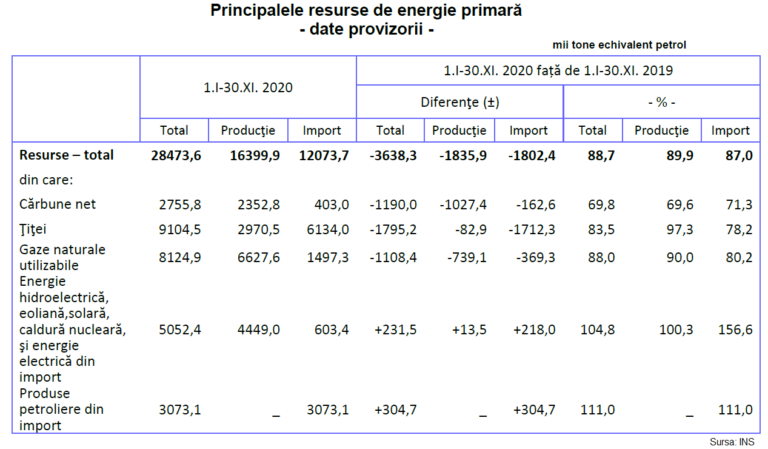 The net import of electricity in first 11 months of 2020 was already higher by 73.9% compared to the whole 2019, despite the consumption reduction, according to the data announced on Friday by the National Institute of Statistics (INS).
The net import of electricity in first 11 months of 2020 was already higher by 73.9% compared to the whole 2019, despite the consumption reduction, according to the data announced on Friday by the National Institute of Statistics (INS).
The population’s consumption increased by 4.3%, but the consumption of the economy decreased by 6.3% due to the recession caused by the pandemic. The economy consumes 74.8% of the total.
December will bring the net increase in imports up to over 74% for the entire 2020, as there were no reasons to reverse the trend since the beginning of the year.
Between January 1 and November 30, net electricity imports amounted to 2.64 billion kWh (2.64 million MWh, or 2,640 GWh, or 2.64 TWh), in order to support a total final consumption decreasing by 4%, down to 48.54 TWh.
Imports increased by 56.5% compared to the first 11 months of 2019, more than exports (+ 40.6%).
The Romanian electricity market is interconnected (coupled) at the price level with Hungary, the Czech Republic and Slovakia, which means that lower prices on these markets encourage Romanian imports.
*
- Electricity balance
- Preliminary data
- Million kWh Difference (+/-), in million kWh
- Sources (total)
- – Production
- – in classic thermal power plants
- – hydroelectric plants
- – nuclear power plants
- – wind power stations
- – photovoltaic power plants
- – Import
- Usage (total)
- – final consumption
- – in economy
- – public lighting
- – population
- – Own technologic consumption in grids and stations
- – Export
*
The decrease in final electricity consumption (-4%) was higher than in production, which decreased by 6.5% to 50.62 TWh.
The largest decrease was registered by “classic thermal power plants” production, of – 15.5% down to 18.17 TWh, with the vast majority of capacities on coal.
Oltenia Energy Complex usually provides 20% of the country’s electricity consumption, using lignite, but at high costs due to the spending on green certificates, required by the high pollution level. CE Oltenia was on the verge of insolvency because of this.
Import of oil products has also increased
While fuel producers reduced their volumes, imports of oil products increased by 11%, to 3.073 million tonnes of oil equivalent (toe).
*
- Main primary energy sources
- Preliminary data
- Thousands of tonnes equivalents
- Changes
- Total Production Import Total Production Import Total Production Import
- Sources- total
- Of which
- Net coal
- Oil
- Usable natural gas
- Hydroelectric, wind, solar, nuclear energy and electricity from imports
- Oil products from import
*
Between January 1 and November 30, 2020, primary energy sources decreased by 11.3% compared to the same period of 2019, to 28.47 million toe.
Production decreased by 10.1% to 16.4 million toe, and total imports decreased by 13% to 12.07 million toe.











